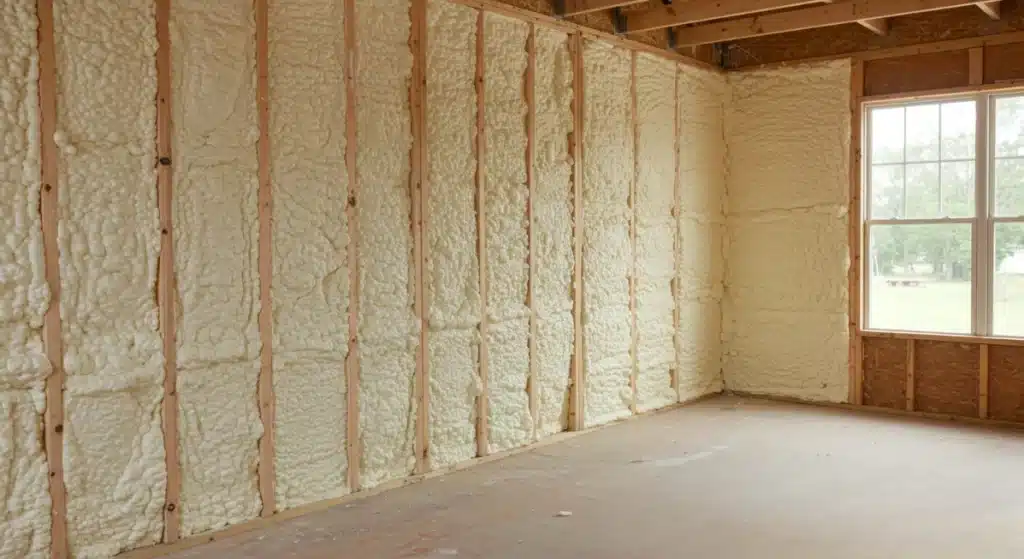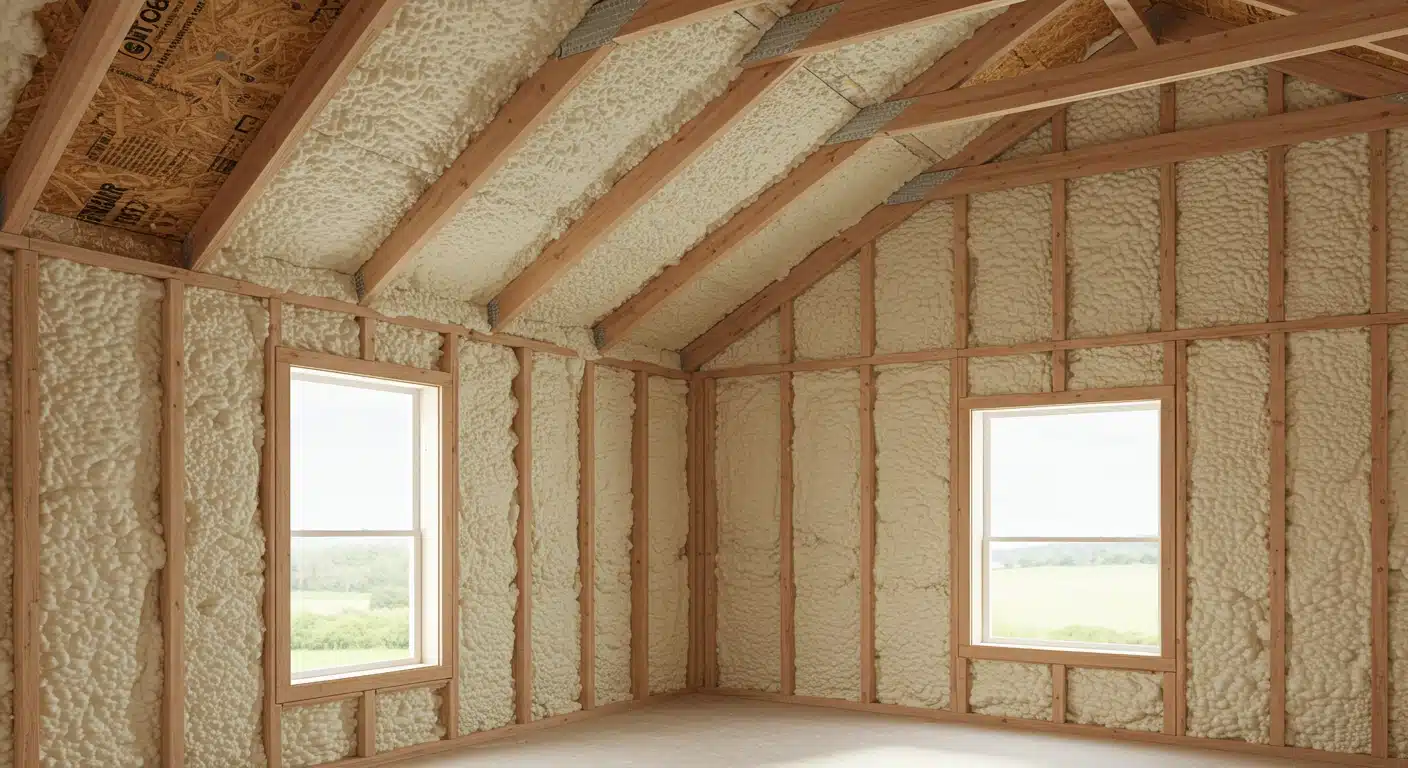Spray foam insulation improves temperature stability in homes and commercial buildings by sealing air leaks and reducing heat transfer. In a climate like Perico, TX, where temperature extremes are common, this insulation type helps maintain consistent indoor comfort throughout the year. It adapts well to seasonal changes, offering high thermal resistance during both summer heat and winter cold.
Flatland Roofing & Insulation draws on years of hands-on experience with spray foam products across diverse Texas properties. This article provides in-depth information backed by direct field application and updated building science. Readers will find key comparisons, technical data, local considerations, and guidance for effective decision-making.
How Spray Foam Insulation Performs in Perico, TX Conditions
Perico’s semi-arid climate brings hot summers, cold winters, and large daily temperature swings. Conventional insulation struggles with these shifts. Spray foam resists thermal drift, air leakage, and moisture intrusion, which is essential in high-dust, low-humidity regions like the Texas Panhandle.
Key Advantages
- Reduces energy loss from uncontrolled air exchange
- Seals gaps in framing cavities and rooflines
- Deters mold by limiting moisture absorption
- Adds structural rigidity to walls and roofs
Bonus Tip
Use closed-cell spray foam in roof decks and unvented attics. It prevents condensation and improves HVAC efficiency in areas with major temperature fluctuation.
Comparison of Insulation Types
| Insulation Type | Air Seal | Moisture Resistance | R-Value per Inch | Cost (Per Sq Ft) | Typical Use Cases |
|---|---|---|---|---|---|
| Spray Foam (Closed) | Yes | High | 6.0–7.0 | $1.00–$1.50 | Roof decks, basements, exteriors |
| Spray Foam (Open) | Yes | Moderate | 3.5–3.7 | $0.45–$0.75 | Interior walls, attics |
| Fiberglass Batts | No | Low | 2.9–3.8 | $0.30–$0.50 | Wall cavities, floors |
| Blown-In Cellulose | Partial | Moderate | 3.2–3.8 | $0.60–$1.00 | Attics, dense-pack retrofits |
Technical Data and Performance Metrics
| Specification | Closed-Cell Spray Foam | Open-Cell Spray Foam |
|---|---|---|
| R-Value (Per Inch) | 6.5 | 3.6 |
| Water Absorption | <1% | ~5% |
| Air Barrier Thickness | 1 inch | 3 inches |
| Vapor Retarder | Yes | No |
| Compressive Strength | 25–30 psi | 3–4 psi |
| Application Temperature | >40°F surface temp | >40°F surface temp |
Bonus Tip
Avoid installing open-cell spray foam near unconditioned crawlspaces in Perico. The seasonal humidity drop can dry it out over time, reducing flexibility and performance.

Things to Consider Before Making a Decision
- Building Type: Commercial and agricultural structures often benefit more from closed-cell foam due to its strength and low permeability.
- Budget Allocation: Spray foam has a higher upfront cost but often yields ROI within 3–5 years through utility savings.
- Existing Construction: Retrofitting older homes may require careful prep, especially around knob-and-tube wiring or aged framing.
- Climate-Specific Needs: In Perico, sealing thermal bypasses is more effective than adding insulation mass. Spray foam’s air sealing feature becomes more critical than raw R-value.
- Installation Access: Tight crawlspaces and obstructed attic eaves limit foam expansion. Professional application is needed to avoid incomplete fills or over-spraying.
Closely Related Services from Flatland Roofing & Insulation
- Blown-In Insulation Installation: Effective for attics and retrofit projects where full cavity coverage is needed.
- Dense-Pack Cellulose: Ideal for existing wall cavities with minimal access.
- Residential Insulation Services: Combines air sealing, thermal upgrades, and safety inspections.
- Commercial Insulation Solutions: Focused on large-scale energy loss reduction in metal buildings, retail, and farm structures.
Common Questions Before Choosing Spray Foam Insulation
How long does spray foam last?
Spray foam maintains performance for 20+ years when properly installed and protected from UV exposure.
Does it cause indoor air issues?
When cured correctly, spray foam is inert. Temporary off-gassing occurs during installation and requires short-term ventilation.
Can it be added to existing walls?
Only with cavity access. Dense-pack cellulose or blown-in options are better for enclosed spaces.
Is it rodent-proof?
Spray foam is not a food source, but rodents may burrow if entry points remain unsealed.
Get Expert Insulation Guidance
For precise recommendations and installation assessments in Perico, contact Flatland Roofing & Insulation.
- Phone: (806) 606-6794
- Email: [email protected]
Frequently Asked Questions About Long-Term Use
What maintenance does spray foam need over time?
Inspect for UV degradation in exposed areas and monitor for punctures during roof or attic work.
Can it be painted or coated?
Yes. Closed-cell foam can be painted or covered with ignition barriers in code-required areas.
Does it reduce sound?
Open-cell spray foam offers some acoustic dampening, but closed-cell is better for thermal insulation.
Is it safe in fire-prone areas?
Spray foam requires a thermal barrier like drywall. It passes building code with correct ignition-resistant coatings.
How does it interact with HVAC systems?
Improves HVAC efficiency by reducing cycling. A post-install HVAC assessment is recommended






